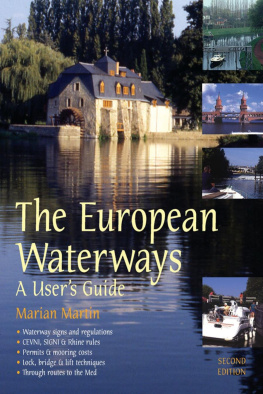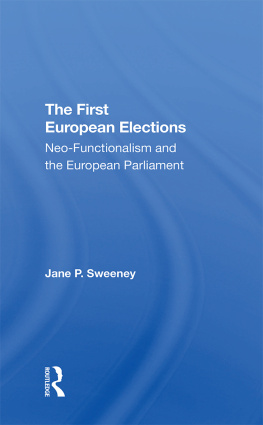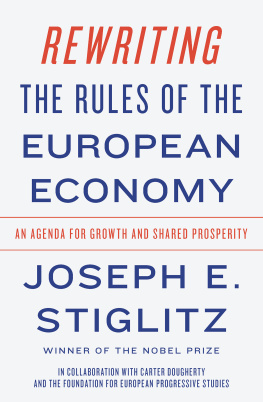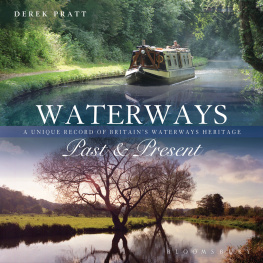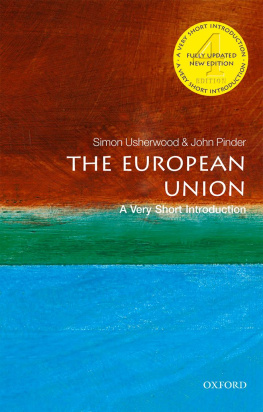Marian Martin - The European Waterways: A Users Guide
Here you can read online Marian Martin - The European Waterways: A Users Guide full text of the book (entire story) in english for free. Download pdf and epub, get meaning, cover and reviews about this ebook. year: 2013, publisher: Bloomsbury Publishing, genre: Romance novel. Description of the work, (preface) as well as reviews are available. Best literature library LitArk.com created for fans of good reading and offers a wide selection of genres:
Romance novel
Science fiction
Adventure
Detective
Science
History
Home and family
Prose
Art
Politics
Computer
Non-fiction
Religion
Business
Children
Humor
Choose a favorite category and find really read worthwhile books. Enjoy immersion in the world of imagination, feel the emotions of the characters or learn something new for yourself, make an fascinating discovery.
- Book:The European Waterways: A Users Guide
- Author:
- Publisher:Bloomsbury Publishing
- Genre:
- Year:2013
- Rating:5 / 5
- Favourites:Add to favourites
- Your mark:
- 100
- 1
- 2
- 3
- 4
- 5
The European Waterways: A Users Guide: summary, description and annotation
We offer to read an annotation, description, summary or preface (depends on what the author of the book "The European Waterways: A Users Guide" wrote himself). If you haven't found the necessary information about the book — write in the comments, we will try to find it.
The European Waterways: A Users Guide — read online for free the complete book (whole text) full work
Below is the text of the book, divided by pages. System saving the place of the last page read, allows you to conveniently read the book "The European Waterways: A Users Guide" online for free, without having to search again every time where you left off. Put a bookmark, and you can go to the page where you finished reading at any time.
Font size:
Interval:
Bookmark:

S ince the first edition of European Waterways was published, interest in inland waterway cruising has grown in leaps and bounds.
In the UK the first new waterways in centuries have recently been built, or are at the planning stage. In France, inland ports de plaisance have proliferated and existing ones have grown to accommodate increased demand, and every year more and more north Europeans and Scandinavians are to be found in southern France. Continental boat hire companies have built more bases, increased the number of boats in existing ones and expanded into Germany and Italy, as ever growing numbers decide to try this type of holiday.
Our enthusiasm for inland waterway wandering began many years ago, when friends invited us aboard their river cruiser. In those days, suggestions about where to go and factual information about what you needed to know when you got there was not easy to acquire. Even today, misleading information abounds. This book aims to dispel myths and provide the guidance you need to enjoy every aspect of inland waterway exploration, whether you are a complete newcomer to boating, or an old hand looking to expand your cruising horizons.
Sections on choice of boat, cruising grounds and waterway rules and regulations apply to all, but there are a number of subjects on which non-Europeans need specific information, so we have included a new chapter on this in the second edition.
We have also, at the request of many sailors, included a chapter with specific advice for those who do not want to linger inland, but need specific help in choosing and negotiating a through route to the Mediterranean.
So, wherever you set out from, this book will help you to find that ideal waterway and reach it without trauma. Read it before you set out, then keep it handy on board so that, unlike us and many other newcomers to inland waterways, you wont have to learn by your mistakes.
As in the previous edition, all handling techniques described in this book are based on the assumption that any boat will have a crew of at least two, because one person cannot safely manoeuvre a boat in all circumstances. In the case of narrow boats, we have assumed that any vessel over 50 feet (15 metres) long will have a minimum crew of three. From time to time one reads descriptions of gymnastic techniques invented by singlehanded cruisers to negotiate a particular lock or bridge. It is obvious that these acrobats are inordinately proud of their achievements but, in truth, many of the techniques are foolhardy, even dangerous.
The only real problem in writing this book has been deciding what to leave out. After a lot of discussion, we decided not to include information about basic boat handling, boating terminology, knot tying and various other bits of knowledge that are a precursor to happy cruising. Our logic was that these things have already been the subject of innumerable books and magazine articles, so our space could be better used to write about less well-documented subjects. In any case, we believe that anyone who takes up boating should take a course of instruction and obtain an appropriate qualification, and thus be familiar with things like current effect and clove hitches.
We also decided to minimise our use of boating parlance, for two reasons. Firstly, for example, saying anything other than Wheres the loo/toilet/WC? on an inland waterway cruiser is as inappropriate as taking a day trip to France and asking the ferry purser to direct you to the heads! Secondly, you will want to invite friends on board and they may not be boating oriented so, in the interest of clear communication, it is much better to give instructions in everyday language.
There is, however, one foreign expression that we have used throughout the book, because it is a lot simpler to adopt the French word plaisancier than to constantly write a person who is using a boat for pleasure purposes. So read on, plaisancier, then go out and discover the ever-changing horizons that inland cruising will reveal to you.
Marian Martin
W here the voyage is more important than the destination is the Gota Canal Steamship companys slogan, and nothing describes quite so aptly the principal reason that every boating enthusiast should try inland cruising. Once you start, youll find that it is decidedly addictive. Every river bend brings a new view, every few miles along a canal there is another village to explore, a place to take a country walk or simply somewhere to picnic, every lake has something different beside its shore, and even when the scenery is less attractive than usual, the antics of people, water birds and animals are entertaining.
Whether you have a sailing yacht, a tiny trailer boat, or a motor cruiser, you will find a waterway to suit your boat somewhere. Regardless of your interests; nature, history, gourmet eating, city life, there will be a place to satisfy your needs and those of your companions. Whether you are a lifelong cruiser or a boating beginner, there are waterways to suit your experience, from challenging passages along mighty rivers to tideless, sheltered waters which are perfect places to learn to sail.
Inland waterway cruising makes extended visits to nations capitals affordable (imagine what it would cost to rent a cottage in a Paris suburb), and weve found that there is no better way of learning about the culture and customs of a country, and meeting its people, than by cruising its canals and rivers. Nothing could be further from the world of the average tourist, where chain hotel rooms in Saudi hardly differ from those in Swansea. On waterways you moor by cottages and fall into conversation (even if it is mainly in sign language) when the owner comes out to admire your boat, or tell you where to buy bread. You go to local markets and suss out the best places for bargains and whether you are in Birmingham, Brussels or Bengtsfors you can guarantee that youll be able to sample unusual food and drink.
In the first edition of European Waterways, we said that people who cruise inland waterways usually fall into one of two main categories: those on holiday; and those who have sold house and home, bought the biggest, best equipped boat they could afford and gone off on a cruise without end. It was also mentioned that we had found a way of enjoying extensive inland cruising, without ripping up all our roots; by cruising to a new region, exploring it, then leaving the boat there for several months, until it was time to go off again. At that time, the book also highlighted that our no fixed abode approach to keeping a boat inland had not been expensive, because each time we wanted to leave it we had been able to find a less than fashionable marina, or a small boatyard, to accommodate the vessel at very reasonable cost.
Today, we meet more and more people who are cruising in similar stages but, unfortunately, in several regions it is no longer quite as simple and inexpensive as it used to be. This is particularly true of southern France, close to the Mediterranean, where a combination of the increased popularity of inland cruising and sailing yacht owners seeking a winter home, has resulted in a shortage of berths. Last winter, we asked the owners of a Med bound yacht why they had chosen to moor during winter in Toulouses marina, rather than at the warmer end of the Canal Entre-deux-Mers. Because friends told us they were fighting for berths over there, was the reply. So, if you want to cruise in fits and starts, advance planning is now essential.
Even if you do decide on a permanent life afloat, you still dont need to sell up, or get hocked up, because a very ordinary boat can be made into a pleasant inland cruiser. In fact, spending a lot of money will not necessarily ensure that you acquire the perfect go anywhere boat. During our wanderings, we have met people who bought boats at 40 000, 60 000 and even 100 000 plus, which were by no means ideal. On the other hand, we have cruised thousands of kilometres in a boat that was fifteen years old when we bought it, cost a fraction of those sums, and has been a superb sea and inland waterway boat.
Next pageFont size:
Interval:
Bookmark:
Similar books «The European Waterways: A Users Guide»
Look at similar books to The European Waterways: A Users Guide. We have selected literature similar in name and meaning in the hope of providing readers with more options to find new, interesting, not yet read works.
Discussion, reviews of the book The European Waterways: A Users Guide and just readers' own opinions. Leave your comments, write what you think about the work, its meaning or the main characters. Specify what exactly you liked and what you didn't like, and why you think so.

